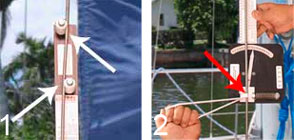Manufacturer part #: RT-10
The gauges measure tension over a range of approximately 5% to 25% of the breaking strength of the cable and provide an accuracy of + or - 5%.
| Part No. | Description |
|---|---|
| Model RT - 10 | Rod Sizes .172, .198, .225, .250, .281 |
| Model RT - 11 | Rod Sizes .281, .330, .375 |
Loos offer a series of gauges to measure the tension in rods from .172 to .375 inch in diameter over a range of approximately 5% to 25% of the breaking strength of the rod and provide an accuracy of + or - 5%. The "Professional Model" RT series provides an increasing durability, accuracy and convenience of use.
Manufactured of rugged anodized aluminum, this gauge is corrosive resistant and will give years of service. Detailed operating instructions are included with each tension gauge. Operates in the same manner as the Professional Model Series.
 Hold the gauge with the right hand and place the rod between the two nylon spools as shown in Figure 1.
Hold the gauge with the right hand and place the rod between the two nylon spools as shown in Figure 1.
With the left hand pull the lanyard and extend the spring until the hook on the nylon slider can be hooked on the rod as shown in Figure 2.
Release the lanyard. Read the needle position on the scale. Refer to the calibration table to obtain correct tension in the rod. The gauge can be left on the wire for "hands free" adjustment of the rod.
To assure accurate readings make sure that the slider moves freely in the frame slot and does not bind. Lubricate the slider slot frequently with silicone lubricant.
How Much Tension
Table 1 recommends an initial tension setting, but there is no simple solution since the optimum rigging tension will be a function of the boat design, the rig (masthead or fractional, one or more spreaders, etc.), and even the cut of the sails. Many skippers use insufficient tension because of a fear of "breaking something." It should be noted that on America's Cup contenders, where electronic state of the art tension instrumentation is available, the standing rigging is set as tight as is structurally feasible.
| Table 1 | |||
|---|---|---|---|
| 302/304 1x19 Stainless Steel Rigging Cable | |||
| Ø In. | Breaking Strength Pounds | Forestay* Pounds | Shrouds* Pounds |
| 3/32 | 1200 | 180 | 120 |
| 1/8 | 2100 | 320 | 240 |
| 5/32 | 3300 | 500 | 350 |
| 3/16 | 4700 | 750 | 500 |
| 7/32 | 6300 | 1000 | 700 |
| 1/4 | 8200 | 1300 | 850 |
| 9/32 | 10300 | 1600 | 1050 |
| 5/16 | 12500 | 2000 | 1300 |
| 3/8 | 17500 | 2750 | 1850 |
* Suggested initial settings.
One Design Class Racing Sailboats
Most sail makers who produce sails for the one design classes provide each purchaser with specific set of readings on theLoos Model A or Model B tension gauges for use when setting up the standing rigging. This assures that the sails will have the correct shape when the rig is under load.
For the convenience of sailors who wish to upgrade from our Model A or B gauges to the professional model (PT-1, PT-2, or PT-3) gauges we include below a conversion chart so that the same recommended tension can be obtained with the PT-1, PT-2 or PT-3 gauges as with the Model A or B gauges.
| Model A | Model Pt-1 | Model B | Model Pt-2 | Model Pt-3 | ||||
|---|---|---|---|---|---|---|---|---|
| 3/32 | 1/8 | 5/32 | SCALE | 3/16 | 7/32 | 1/4 | 9/32 | |
| 5 | 6 | 10 | 11 | |||||
| 10 | 9 | 15 | 13 | |||||
| 15 | 12 | 14 | 18 | 15 | ||||
| 20 | 16 | 16 | 20 | 16 | 18 | |||
| 25 | 20 | 19 | 22 | 18 | 20 | |||
| 28 | 23 | 21 | 24 | 19 | 22 | |||
| 30 | 22 | 26 | 21 | 24 | ||||
| 35 | 27 | 25 | 28 | 23 | 25 | |||
| 38 | 30 | 28 | 30 | 25 | 27 | 25 | ||
| 40 | 33 | 30 | 32 | 27 | 29 | 27 | ||
| 42 | 33 | 34 | 29 | 31 | 39 | |||
| 44 | 36 | 36 | 33 | 31 | ||||
| 45 | 38 | 38 | 36 | 33 | 6 | |||
| 46 | 39 | 39 | 37 | 34 | 7 | |||
| 47 | 40 | 40 | 36 | 9 | ||||
| 41 | 37 | 10 | ||||||
| 42 | 39 | 11 | ||||||
| 43 | 40 | 12 | ||||||
| 44 | 14 | |||||||
| 45 | 16 | |||||||
| 46 | 18 | |||||||
| 47 | 20 | |||||||
| 49 | 25 | |||||||





